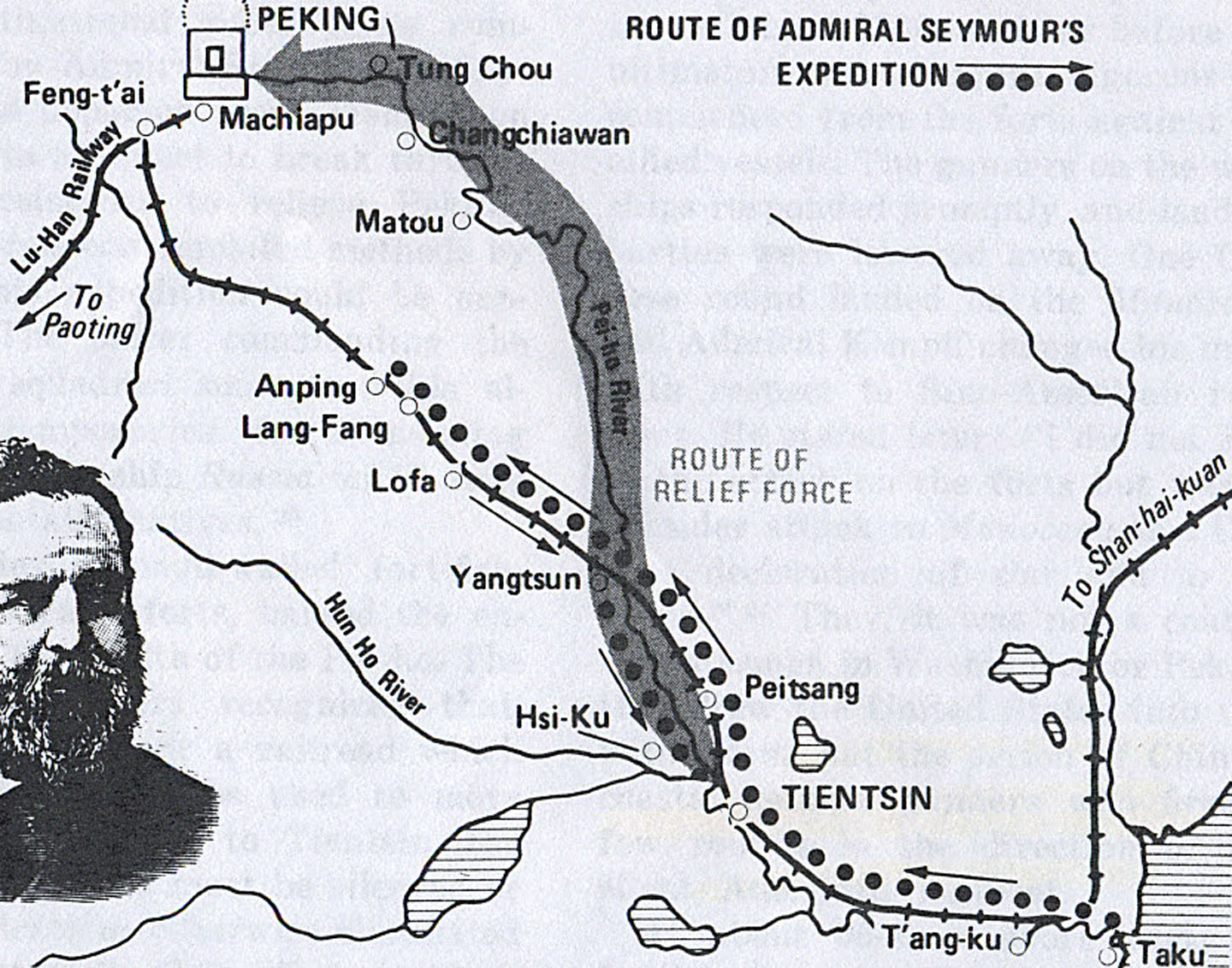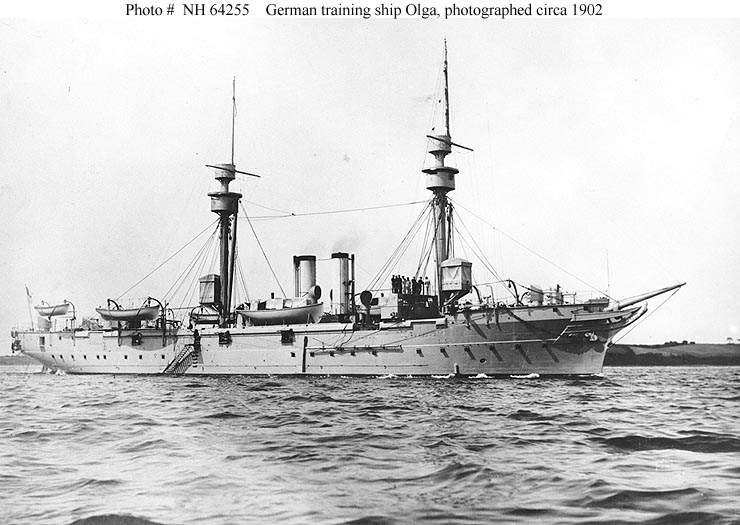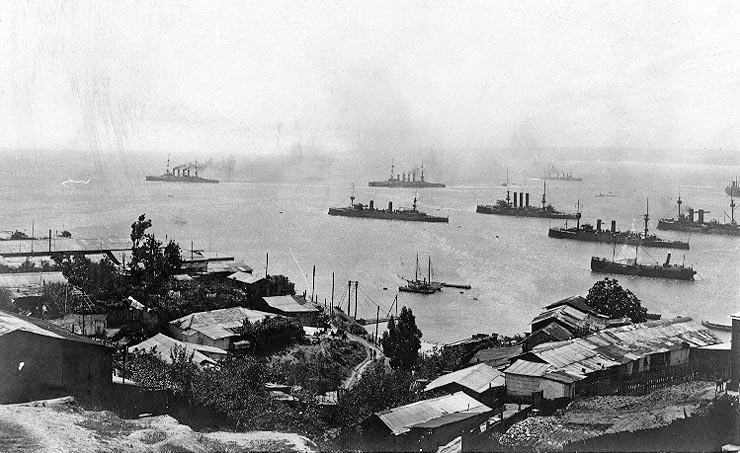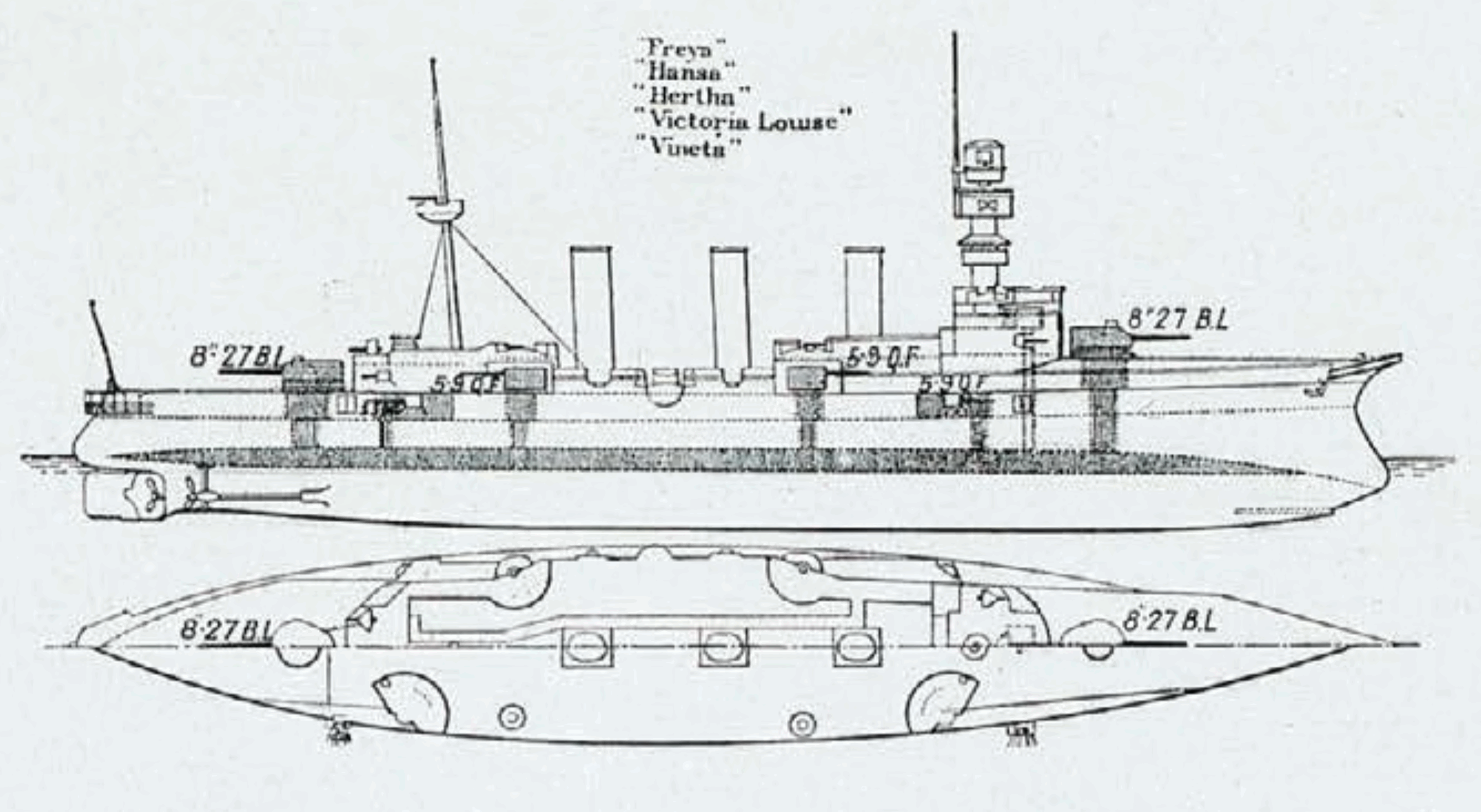|
Guido Von Usedom
Guido von Usedom (October 2, 1854February 24, 1925) was a German admiral that served in the Boxer Rebellion and World War I. His most notable service was in the Dardanelles Campaign. Biography Early Years Guido came from the Pomeranian noble family Usedom and was the son of Lieutenant Kuno von Usedom (1804–1855). He joined the Imperial German Navy on May 31, 1871. After his training and his first tours of duty on board, he was given his first command. For a time he served as adjutant to Prince Henry of Prussia. In October 1895, Usedom, with the rank of Korvettenkapitän (Lieutenant Commander), was in command of the aviso (dispatch vessel) SMS Pfeil until the end of the year, and from March 1896 he was in command of the aviso SMS Jagd for six months. From September 1896 to July 1898 he was in command of the coastal defence ship SMS Hagen and was made a Senior Korvettenkapitän during this time. He then took command of the large cruiser SMS Hertha, which had just been pu ... [...More Info...] [...Related Items...] OR: [Wikipedia] [Google] [Baidu] |
Korvettenkapitän
() is the lowest ranking senior officer in a number of Germanic-speaking navies. Austro-Hungary Belgium Germany Korvettenkapitän, short: KKpt/in lists: KK, () is the lowest senior officer rank () in the German Navy. Address The official manner, in line to ZDv 10/8, of formal addressing of military people with the rank ''Korvettenkapitän'' (OF-3) is "Herr/Frau Korvettenkapitän". However, as to German naval traditions the "Korvettenkapitän" will be addressed "Herr/Frau Kapitän", often in line to seamen's language "Herr/Frau Kap'tän". Rank insignia and rating Rank insignia ''Korvettenkapitän'', worn on the sleeves and shoulders, are one five-pointed star above three stripes (or rings on sleeves; without the star when rank loops are worn). The rank is rated OF-3a in NATO, and equivalent to Major in Heer, and Luftwaffe. It is grade A13 in the pay rules of the Federal Ministry of Defence and is senior to the regular OF-2 rank of Kapitänleutnant (en: Lt), as wel ... [...More Info...] [...Related Items...] OR: [Wikipedia] [Google] [Baidu] |
Edward Seymour (Royal Navy Officer)
Admiral of the Fleet Sir Edward Hobart Seymour, (30 April 1840 – 2 March 1929) was a Royal Navy officer. As a junior officer he served in the Black Sea during the Crimean War. He then took part in the sinking of the war-junks, the Battle of Canton and the Battle of Taku Forts during the Second Opium War and then saw action again at the Battle of Cixi during the Taiping Rebellion. Seymour went on to be Second-in-Command of the Channel Squadron and then Admiral Superintendent of Naval Reserves. After that he became Commander-in-Chief, China Station. During the Boxer Rebellion, he led an expedition of 2,000 sailors and marines from Western and Japanese warships to relieve the besieged diplomatic legations in Peking. The expedition was defeated by Chinese and Boxer forces and had to return to Tianjin. Although the mission had failed, when Seymour arrived back at Portsmouth he and his men were welcomed by thousands of people lining the beach and pier. Early career Born the ... [...More Info...] [...Related Items...] OR: [Wikipedia] [Google] [Baidu] |
Beijing
} Beijing ( ; ; ), alternatively romanized as Peking ( ), is the capital of the People's Republic of China. It is the center of power and development of the country. Beijing is the world's most populous national capital city, with over 21 million residents. It has an administrative area of , the third in the country after Guangzhou and Shanghai. It is located in Northern China, and is governed as a municipality under the direct administration of the State Council with 16 urban, suburban, and rural districts.Figures based on 2006 statistics published in 2007 National Statistical Yearbook of China and available online at archive. Retrieved 21 April 2009. Beijing is mostly surrounded by Hebei Province with the exception of neighboring Tianjin to the southeast; together, the three divisions form the Jingjinji megalopolis and the national capital region of China. Beijing is a global city and one of the world's leading centres for culture, diplomacy, politics, finance, busi ... [...More Info...] [...Related Items...] OR: [Wikipedia] [Google] [Baidu] |
Felix Von Bendemann
Felix von Bendemann (8 August 1848 – 31 October 1915) was an Admiral of the German Imperial Navy (Kaiserliche Marine). Early life Bendemann was born in Dresden, Kingdom of Saxony. He was the son of the painter Eduard Julius Friedrich Bendemann (1811–1889) and Lida Schadow, who was the daughter of the sculptor Johann Gottfried Schadow. The painter Rudolf Bendemann was his brother. Naval career Bendemann and three brothers served in the Franco-Prussian War in 1870–71. He was in the Prussian Navy as an officer on the gunboat in Key West when the war began. On 23 October the news of the outbreak of war reached the ship's captain, Eduard von Knorr. The SMS ''Meteor'' sailed for Cuba where, on 9 November they fought the only serious naval battle of the war with the French aviso ''Bouvet'' commanded by capitaine de frégate Alexandre Franquet. After an artillery exchange and an attempts by the ''Bouvet'' to ram the ''Meteor'', both ships were incapacitated. Altho ... [...More Info...] [...Related Items...] OR: [Wikipedia] [Google] [Baidu] |
East Asia Squadron
The German East Asia Squadron (german: Kreuzergeschwader / Ostasiengeschwader) was an Imperial German Navy cruiser Squadron (naval), squadron which operated mainly in the Pacific Ocean between the mid-1890s until 1914, when it was destroyed at the Battle of the Falkland Islands. It was based at Germany's Kiautschou Bay concession in China. Background The Treaty of Tientsin, Treaty of Peking of September 1861 between the Kingdom of Prussia and China allowed Prussian warships to operate in Chinese waters. As East Asia grew in economic and political importance to the recently united Germany, in 1881 a flying squadron was formed for the area under the command of a flag officer. Since African colonies were then seen as of greater value, an African Cruiser Squadron was established in 1885 with permanent status, and shortly thereafter the Imperial German Navy reduced the East Asia presence to two small gunboats. From 1888 to 1892, was flagship of the German East Asia Squadron, initial ... [...More Info...] [...Related Items...] OR: [Wikipedia] [Google] [Baidu] |
East Asia
East Asia is the eastern region of Asia, which is defined in both geographical and ethno-cultural terms. The modern states of East Asia include China, Japan, Mongolia, North Korea, South Korea, and Taiwan. China, North Korea, South Korea and Taiwan are all unrecognised by at least one other East Asian state due to severe ongoing political tensions in the region, specifically the division of Korea and the political status of Taiwan. Hong Kong and Macau, two small coastal quasi-dependent territories located in the south of China, are officially highly autonomous but are under Chinese sovereignty. Japan, Taiwan, South Korea, Mainland China, Hong Kong, and Macau are among the world's largest and most prosperous economies. East Asia borders Siberia and the Russian Far East to the north, Southeast Asia to the south, South Asia to the southwest, and Central Asia to the west. To the east is the Pacific Ocean and to the southeast is Micronesia (a Pacific Ocean island group, classifi ... [...More Info...] [...Related Items...] OR: [Wikipedia] [Google] [Baidu] |
Mediterranean Sea
The Mediterranean Sea is a sea connected to the Atlantic Ocean, surrounded by the Mediterranean Basin and almost completely enclosed by land: on the north by Western and Southern Europe and Anatolia, on the south by North Africa, and on the east by the Levant. The Sea has played a central role in the history of Western civilization. Geological evidence indicates that around 5.9 million years ago, the Mediterranean was cut off from the Atlantic and was partly or completely desiccated over a period of some 600,000 years during the Messinian salinity crisis before being refilled by the Zanclean flood about 5.3 million years ago. The Mediterranean Sea covers an area of about , representing 0.7% of the global ocean surface, but its connection to the Atlantic via the Strait of Gibraltar—the narrow strait that connects the Atlantic Ocean to the Mediterranean Sea and separates the Iberian Peninsula in Europe from Morocco in Africa—is only wide. The Mediterranean Sea e ... [...More Info...] [...Related Items...] OR: [Wikipedia] [Google] [Baidu] |
Kapitän Zur See
Captain is the name most often given in English-speaking navies to the rank corresponding to command of the largest ships. The rank is equal to the army rank of colonel and air force rank of group captain. Equivalent ranks worldwide include ship-of-the-line captain (e.g. France, Argentina, Spain), captain of sea and war (e.g. Brazil, Portugal), captain at sea (e.g. Germany, Netherlands) and " captain of the first rank" (Russia). The NATO rank code is OF-5, although the United States of America uses the code O-6 for the equivalent rank (as it does for all OF-5 ranks). Four of the uniformed services of the United States — the United States Navy, United States Coast Guard, United States Public Health Service Commissioned Corps, and National Oceanic and Atmospheric Administration Commissioned Officer Corps — use the rank. Etiquette Any naval officer who commands a ship is addressed by naval custom as "captain" while aboard in command, regardless of their actual rank, even ... [...More Info...] [...Related Items...] OR: [Wikipedia] [Google] [Baidu] |
Fregattenkapitän
Fregattenkapitän, short: FKpt / in lists: FK, () is the middle field officer rank () in the German Navy. Address In line with ZDv 10/8, the official manner of formally addressing military personnel holding the rank of ''Fregattenkapitän'' (OF-4) is “Herr/Frau Fregattenkapitän“. However, following German naval tradition the “Fregattenkapitän“ is usually addressed as „Herr/Frau Kapitän“ or in seamen's language as „Herr/Frau Kap'tän“. Rank Insignia and Rating Rank insignia ''Fregattenkapitän'', worn on the sleeves and shoulders, are one five-pointed star above three stripes and a half stripe between stripe two and one (or rings on sleeves; without the star when rank loops are worn). The rank is rated OF-4 in NATO, and is equivalent to Oberstleutnant in Heer, and Luftwaffe. It is domiciled at the A14 and A15 pay scale of the Federal Ministry of Defence and is senior to the rank of Korvettenkapitän (NATO OF-3 - ''Commander Junior Grade''). It is of note ... [...More Info...] [...Related Items...] OR: [Wikipedia] [Google] [Baidu] |
SMS Hertha
SMS ''Hertha'' was a protected cruiser of the , built for the German Imperial German Navy, Imperial Navy (''Kaiserliche Marine'') in the 1890s. ''Hertha'' was laid down at the AG Vulcan shipyard in 1895, launched in April 1897, and commissioned into the Navy in July 1898. The ship was armed with a battery of two 21 cm guns and eight 15 cm guns and had a top speed of . ''Hertha'' served abroad in the German East Asia Squadron for the first six years of her career; she served briefly as the Squadron flagship in 1900. She contributed a landing party to the force that captured the Taku Forts during the Boxer Uprising in 1900. After returning to Germany in 1905, she was modernized and used as a training ship in 1908, following the completion of the refit. She conducted a series of training cruises, and several notable officers served aboard the ship as cadets, including Karl Dönitz and Ernst Lindemann. At the outbreak of World War I, ''Hertha'' was mobilized into V Sc ... [...More Info...] [...Related Items...] OR: [Wikipedia] [Google] [Baidu] |
SMS Hagen
SMS was the final vessel of the six-member of coastal defense ships () built for the German Imperial Navy. Her sister ships were , , , , and . was built by the (Imperial Shipyard) in Kiel between 1891 and 1893, and was armed with a main battery of three guns. She served in the German fleet throughout the 1890s and was rebuilt in 1900 - 1902. She served in the VI Battle Squadron after the outbreak of World War I in August 1914, but saw no action. was demobilized in 1915 and used as a barracks ship thereafter. She was ultimately sold for scrap in 1919 and subsequently dismantled. Design In the late 1880s, the German (Imperial Navy) grappled with the problem of what type of capital ship to build in the face of limited naval budgets (owing to parliamentary objections to naval spending and the cost of dredging the Kaiser Wilhelm Canal). General Leo von Caprivi, the new (Chief of the Admiralty), requested a series of design proposals, which ranged in size from small coastal ... [...More Info...] [...Related Items...] OR: [Wikipedia] [Google] [Baidu] |









